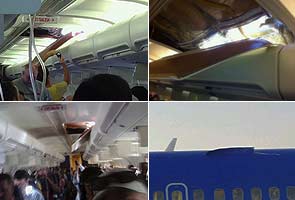
The tear along a riveted "lap joint" shows evidence of extensive cracking that hadn't been discovered during routine maintenance before Friday's flight, and probably wouldn't have been unless mechanics had specifically looked for it, officials said.
National Transportation Safety Board investigators were overseeing the removal of the top section of the jetliner's roof around the 5-foot long tear and will send the structure to Washington, D.C., for analysis.
Meanwhile, Southwest said it had cancelled about 300 flights for the second day in a row on Sunday as it inspected 79 similar planes in its fleet that it has grounded. The NTSB said it had not been notified of similar problems cropping up during those inspections. Southwest has not said if it has found other problems.
No one was seriously injured on Friday as the aircraft carrying 118 people rapidly lost cabin pressure and made a controlled descent from 34,400 feet.
But passengers recalled tense minutes after a hole ruptured overhead with a blast and they fumbled for oxygen masks as the plane descended.
NTSB board member Robert Sumwalt said on Sunday that the rip was a foot wide, and that it started along a joint where two sections of the 737's skin are riveted together. An examination showed extensive pre-existing damage along the entire tear.
But Sumwalt noted that the extensive cracking, known in the industry as "multi-site damage," could not have been spotted during routine maintenance.
The NTSB could issue urgent recommendations for inspections on other 737s if investigators decide there is a problem that has been overlooked. The type of riveted joint involved is not normally subjected to extensive checks for wear or fatigue.
Federal records show cracks were found and repaired a year ago in the frame of the same Southwest plane.
The records show the cracking was either repaired or the damaged parts replaced. Cracking accounted for a majority of the 28 problem reports filed as a result of that inspection.
The plane's voice and data recorders were being examined in Washington, and Sumwalt said they worked well but show no sign of a problem before the incident.
A total of 288 Boeing 737-300s currently operate in the U.S. fleet, and 931 operate worldwide, according to the Federal Aviation Administration. The FAA declined to say Sunday if it was requiring other operators to check their aircraft for similar flaws.
A similar incident happened in July 2009 when a football-sized hole opened up in-flight in the fuselage of another of Southwest's Boeing 737s, depressurising the cabin.


No comments:
Post a Comment